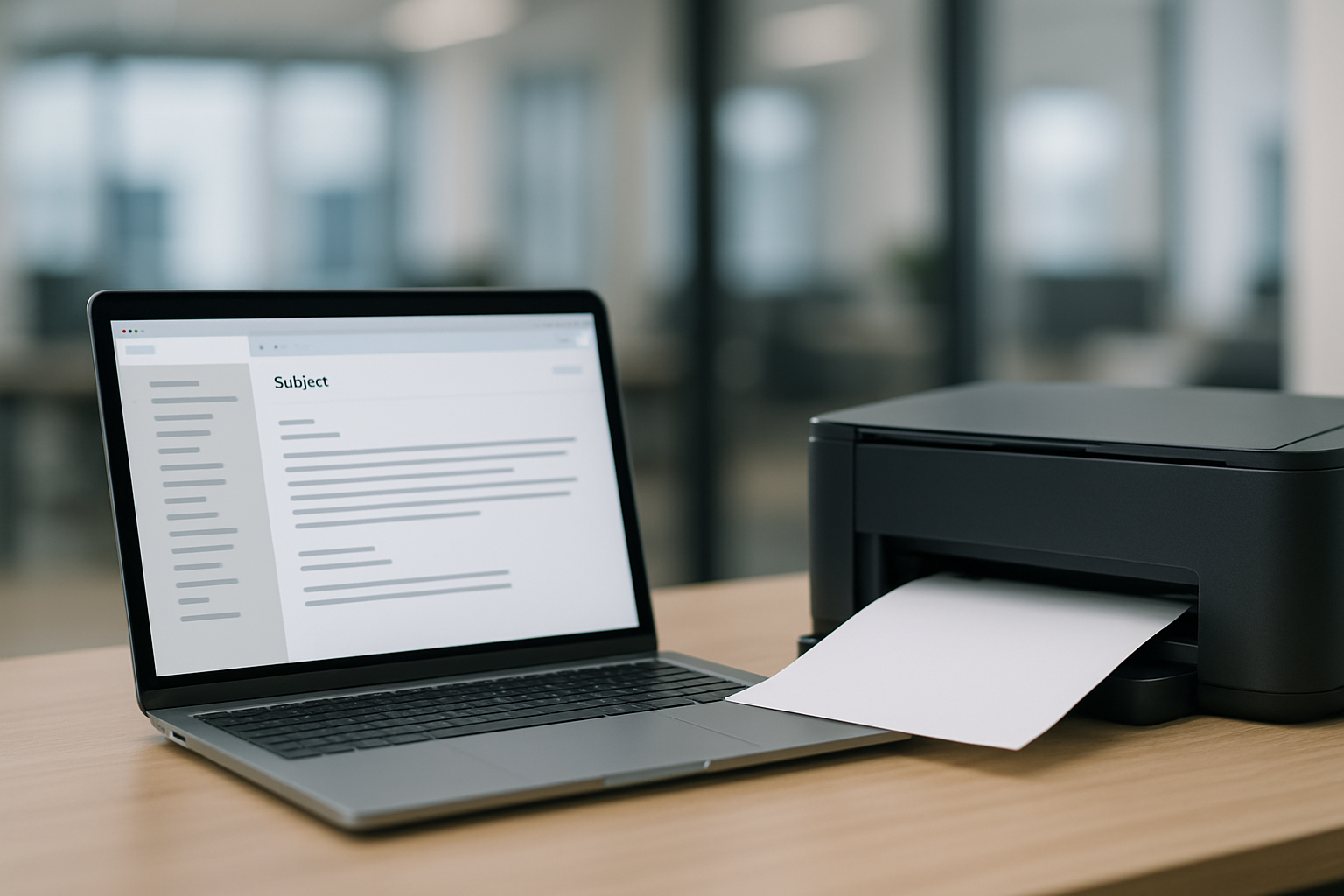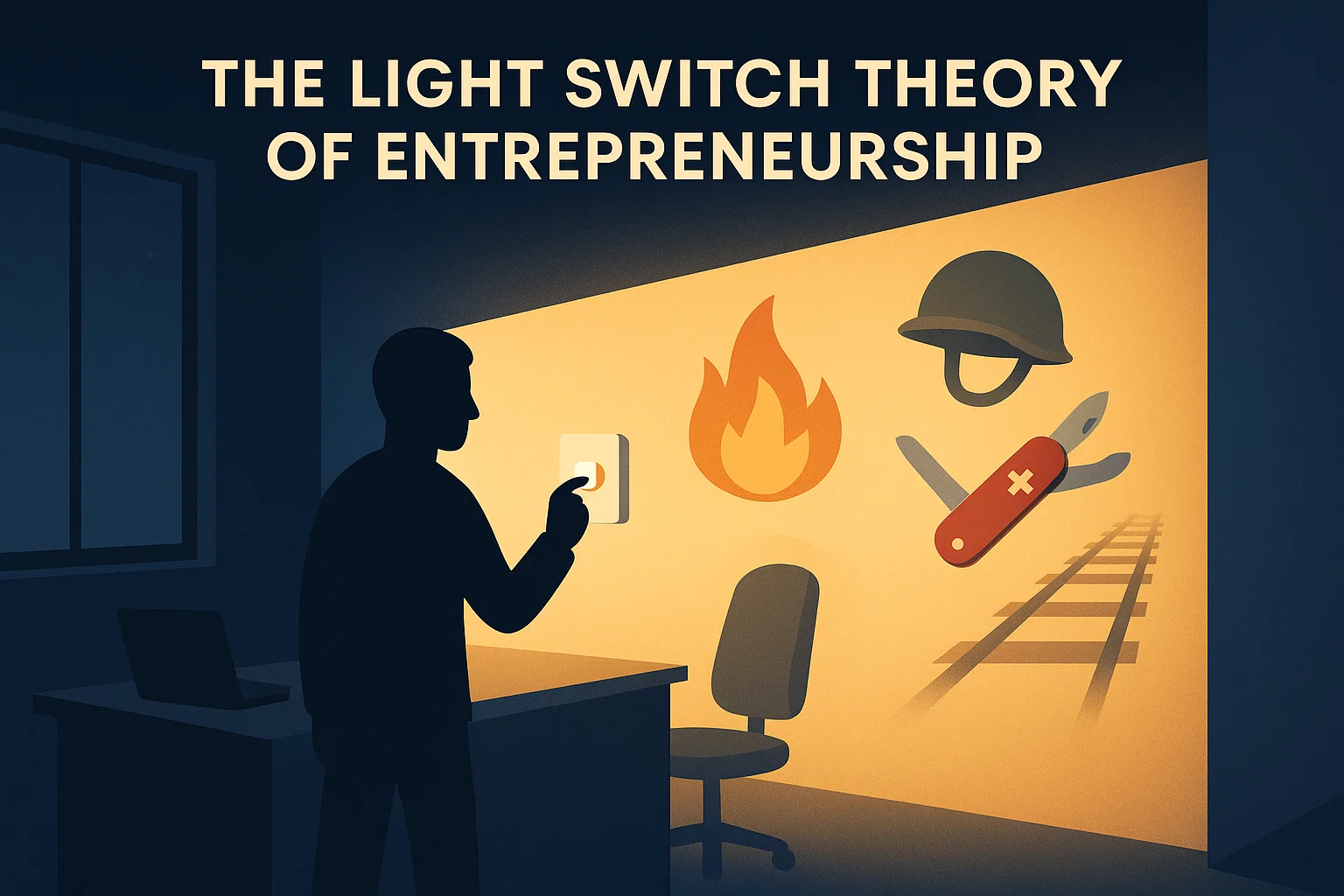It started as a joke.
Lots of my customers once asked me, with a pinch of humour:
“Fred, is it better for the planet if I just print this email instead of sending it?”
I always laughed until I thought: Why not actually do the math?
I’m a carbon accountant, so I dug into the databases and ran the calculations.
So the question is: When does a simple email become more carbon-intensive than its paper-print equivalent? I was shocked by my findings, so the results might surprise you…

The hunt for the numbers
To keep things realistic, I imagined a 250-word email. One person writes it in 10 minutes, another spends 2 minutes reading it. That’s 12 minutes of device use in total.
Device manufacture
ADEME tells us a professional laptop has a footprint of 185 kgCO₂e over its lifetime. If it lasts 5 years and is used 6 hours a day, during 220 working days, that’s 6,600 hours (≈396,000 minutes). Divide 185,000 g by 396,000 minutes → 0.467 gCO₂e per minute.
Twelve minutes of use = 5.61 gCO₂e just from manufacturing the laptops.
Important disclaimer: This is the main emission source of the dilemma. Thus, any changes in the assumptions will significantly change the results.
Device electricity
The laptops draw about 50 W while active, i.e. 0.05 kW. Over one minute, that’s 0.000833 kWh. Multiply by 12 minutes = 0.010 kWh.
- In France, where the grid emits only 32 gCO₂e/kWh (RTE/Ember 2023), that’s 0.32 gCO₂e.
- In the EU average, closer to 250 gCO₂e/kWh (EEA/Ember), it’s 2.5 gCO₂e.
Networks & data centres
A simple email with a signature is ~200 KB (0.0002 GB). ADEME’s factor is 9.21 gCO₂e/GB (networks + DC, excluding end-user devices). Multiply → 0.0018 gCO₂e. It is negligible compared to manufacture and electricity.
The total email
| Life-cycle stage | France (32 g/kWh) | Share | EU avg (250 g/kWh) | Share |
| Device manufacture (amortized) | 5.61 g | 95% | 5.61 g | 69% |
| Device electricity (use) | 0.32 g | 5% | 2.50 g | 31% |
| Networks + data centres | 0.002 g | <0% | 0.002 g | <0% |
| Total | 5,93 g | 100% | 8,11 g | 100% |
These results are actually close to ADEME’s 4.7 g/mail (for one sender + one recipient). The small gap is explained by their slightly longer assumed times (3 iterations of the message) and some storage impacts. I skipped storage because for a short text-only email, it’s marginal.

Printing isn’t free either
Now let’s switch to paper.
Paper manufacture
Data from COPACEL and ADEME: an A4 sheet of standard 80 g/m² paper = 4.58 gCO₂e.
Printer manufacture
ADEME gives ~197 kgCO₂e for a laser printer. Assume it prints 65,000 pages over its life. Divide 197,000 g / 65,000 ≈ 3 g/page (rounded).
Toner & consumables
For standard black-and-white pages with ~5–10% coverage, ADEME data suggests ~1 gCO₂e per page.
Electricity use
A printer draws ~400 W while printing. One page takes ~5 seconds = 0.00056 kWh. In France: 0.02 gCO₂e, in EU average: 0.14 gCO₂e. Negligible.
The total printed page
| Life-cycle stage | France (32 g/kWh) | % | EU avg (250 g/kWh) | % |
| Paper | 4.58 g | 53% | 4.58 g | 52% |
| Printer manufacture | 3.00 g | 35% | 3.00 g | 34% |
| Toner & process | 1.00 g | 12% | 1.00 g | 11% |
| Electricity | 0.02 g | 0% | 0.14 g | 2% |
| Total | 8.60 g | 100% | 8.72 g | 100% |
So, one printed page is roughly 8.6 gCO₂e, almost double the French email, and about 1.5× the EU-average email.
The twist: CC is the real villain
But here comes the surprise. Each extra recipient adds 2 minutes of reading time. That’s:
- France: ~0.99 g Co2e per added recipient (0.934 embodied + 0.053 electricity + 0.0018 net/DC).
- EU average: ~1.35 g Co2e per added recipient (0.934 + 0.417 + 0.0018).
So the balance flips quickly:
- In France, a printed page = an email sent to ~4 people.
- In EU average, a printed page = an email sent to ~2 people.
The villain isn’t the single email — it’s the CC habit. That innocent button turns grams into tens of grams.
But what if we say “my laptop is already built”?
Now, some of you are probably thinking: “Fred, come on — my laptop is already on my desk. Why should I count its manufacturing footprint every time I send an email?”
Fair question. Let’s play along.
If we exclude the manufacturing impact of the laptop and only keep the electricity to power it + the networks and data centres, the numbers change dramatically:
- One baseline email becomes almost weightless: 0.3 gCO₂e in France, 2.5 gCO₂e in the EU.
- Each extra reader? 0.05 gCO₂e in France, 0.4 gCO₂e in the EU.
The new break-even point?
- In France, you’d need to send your email to about 150 people before it matches the footprint of printing a single page.
- In the EU, it’s around 16 people.
So yes — if you pretend the factory emissions have magically vanished, email looks squeaky clean. But carbon accounting doesn’t work like magic: we have to spread those 185 kilograms of CO₂e per laptop across every minute of its lifetime. Otherwise, the impact just… disappears into thin air (and sadly, carbon doesn’t do that).
Real-world examples
What kinds of emails actually go to more than 5 people? Think about:
- HR policies (“update your password every 90 days”).
- Process reminders (“new expense claim workflow”).
- Notifications (“building closed on Monday for maintenance”).
- Board updates (strategy notes, meeting recaps).
And here’s the kicker: when new employees join, they often get forwarded the same email, or added to the next CC round. The footprint grows exponentially compared to printing the message once and displaying it on a communal board or intranet page, where people can read it as often as needed without new device minutes.

The bottom line
The real weight of an email doesn’t come from the Wi-Fi or electricity — it’s the manufacturing of your laptop. Every minute of use carries about 0.47 gCO₂e. So my 250-word email (10 minutes to write, 2 to read) ends up at about 6 gCO₂e in France and 8 gCO₂e on the EU grid. A printed page? Roughly 9 gCO₂e.
That means in France, sending it to 4 people equals one print; in the EU, just 2 people. The villain? The innocent CC button. Each extra reader adds ~1 gCO₂e. Copy too many people, and you’ve basically become the office printer.
Now, some will say: “But my laptop is already built!” True — if you ignore manufacturing, the email looks feather-light. You’d need 150 recipients in France or 16 in the EU to match one printed page. But in carbon accounting, we can’t just erase the 185 kgCO₂e per laptop. Those emissions happened — and they need to be spread across every minute of use.
The lesson isn’t “always print” or “never email.” It’s: don’t multiply copies. Post once. On Slack, Teams, the intranet, even a noticeboard. Sometimes the greenest choice is just making information visible once, for all.
Technical notes for Carbon Accounting Nerd
Scope
Comparison between a 250-word email (written once, read once) and one printed A4 page.
Boundaries include:
- Email: laptop manufacture & use, electricity, networks & data centres.
- Print: paper, printer manufacture, toner, electricity.
- End-of-life included for laptop and paper.
- Excluded: other end-of-life stages, office building energy and construction.
Assumptions
- Email workload: 10 min writing + 2 min reading = 12 min device time.
- Laptop manufacture: 185 kgCO₂e (ADEME). Lifetime: 5 y, 220 working days/y, 6 h/d = 396,000 min. → 0.467 gCO₂e/min.
- Laptop electricity: 50 W = 0.05 kW. Per min = 0.000833 kWh.
- Grid intensities: France = 32 gCO₂e/kWh (RTE/Ember), EU avg = 250 gCO₂e/kWh (EEA/Ember).
- Data volume: ~200 KB = 0.0002 GB.
- Network & DC factor: 9.21 gCO₂e/GB (ADEME, fixed line).
Print assumptions
- Paper (A4, 80 g/m²): 4.58 gCO₂e (COPACEL/ADEME, incl. end-of-life).
- Printer manufacture: 197 kgCO₂e (ADEME). Lifetime: 65,000 pages. → 3 gCO₂e/page.
- Toner & consumables: ~1 gCO₂e/page (ADEME, B&W ~5–10% coverage).
- Printer electricity: 400 W × 5 s = 0.00056 kWh/page → France: 0.02 gCO₂e; EU: 0.14 gCO₂e.
Disclaimer
This assessment was carried out to the best of my ability using available data from reliable sources (e.g., ADEME). It inevitably involves assumptions, simplifications, and uncertainties. The figures presented should not be taken as exact measurements but as representative values that illustrate the relative orders of magnitude. The goal is to inform and raise awareness, not to provide a definitive carbon accounting of each individual email or printed page.




My meeting with their Majesties King and Queen of Belgium
1 Min Read